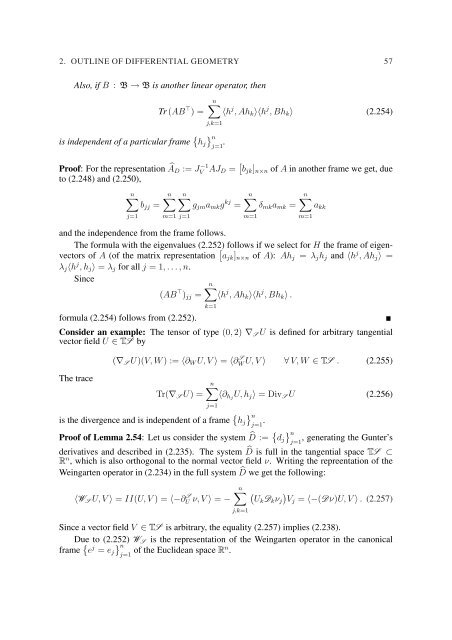EQUATIONS OF ELASTIC HYPERSURFACES
EQUATIONS OF ELASTIC HYPERSURFACES
EQUATIONS OF ELASTIC HYPERSURFACES
Create successful ePaper yourself
Turn your PDF publications into a flip-book with our unique Google optimized e-Paper software.
2. OUTLINE <strong>OF</strong> DIFFERENTIAL GEOMETRY 57<br />
Also, if B : B → B is another linear operator, then<br />
n∑<br />
Tr (AB ⊤ ) = 〈h j , Ah k 〉〈h j , Bh k 〉 (2.254)<br />
j,k=1<br />
is independent of a particular frame { h j<br />
} n<br />
j=1 .<br />
Proof: For the representation ÂD := J −1<br />
V<br />
AJ D = [ b jk ] n×n of A in another frame we get, due<br />
to (2.248) and (2.250),<br />
n∑<br />
b jj =<br />
j=1<br />
n∑<br />
m=1 j=1<br />
n∑<br />
g jm a mk g kj =<br />
n∑<br />
δ mk a mk =<br />
and the independence from the frame follows.<br />
The formula with the eigenvalues (2.252) follows if we select for H the frame of eigenvectors<br />
of A (of the matrix representation [ a jk ] n×n of A): Ah j = λ j h j and 〈h j , Ah j 〉 =<br />
λ j 〈h j , h j 〉 = λ j for all j = 1, . . . , n.<br />
Since<br />
n∑<br />
(AB ⊤ ) jj = 〈h j , Ah k 〉〈h j , Bh k 〉 .<br />
formula (2.254) follows from (2.252).<br />
k=1<br />
Consider an example: The tensor of type (0, 2) ∇ S U is defined for arbitrary tangential<br />
vector field U ∈ TS by<br />
The trace<br />
m=1<br />
(∇ S U)(V, W ) := 〈∂ W U, V 〉 = 〈∂ S W U, V 〉 ∀ V, W ∈ TS . (2.255)<br />
Tr(∇ S U) =<br />
n∑<br />
m=1<br />
a kk<br />
n∑<br />
〈∂ hj U, h j 〉 = Div S U (2.256)<br />
j=1<br />
is the divergence and is independent of a frame { h j<br />
} n<br />
j=1 .<br />
Proof of Lemma 2.54: Let us consider the system ̂D := { } n<br />
d j , generating the Gunter’s<br />
j=1<br />
derivatives and described in (2.235). The system ̂D is full in the tangential space TS ⊂<br />
R n , which is also orthogonal to the normal vector field ν. Writing the repreentation of the<br />
Weingarten operator in (2.234) in the full system ̂D we get the following:<br />
〈W S U, V 〉 = II(U, V ) = 〈−∂ S U ν, V 〉 = −<br />
n∑ ( )<br />
Uk D k ν j Vj = 〈−(Dν)U, V 〉 . (2.257)<br />
Since a vector field V ∈ TS is arbitrary, the equality (2.257) implies (2.238).<br />
Due to (2.252) W S is the representation of the Weingarten operator in the canonical<br />
frame { }<br />
e j n<br />
= e j of the Euclidean space j=1 Rn .<br />
j,k=1

















